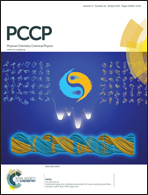Elucidating factors important for monovalent cation selectivity in enzymes: E. coli β-galactosidase as a model†
Abstract
Many enzymes require a specific monovalent cation (M+), that is either Na+ or K+, for optimal activity. While high selectivity M+ sites in transport proteins have been extensively studied, enzyme M+ binding sites generally have lower selectivity and are less characterized. Here we study the M+ binding site of the model enzyme E. coli β-galactosidase, which is about 10 fold selective for Na+ over K+. Combining data from X-ray crystallography and computational models, we find the electrostatic environment predominates in defining the Na+ selectivity. In this lower selectivity site rather subtle influences on the electrostatic environment become significant, including the induced polarization effects of the M+ on the coordinating ligands and the effect of second coordination shell residues on the charge distribution of the primary ligands. This work expands the knowledge of ion selectivity in proteins to denote novel mechanisms important for the selectivity of M+ sites in enzymes.


 Please wait while we load your content...
Please wait while we load your content...